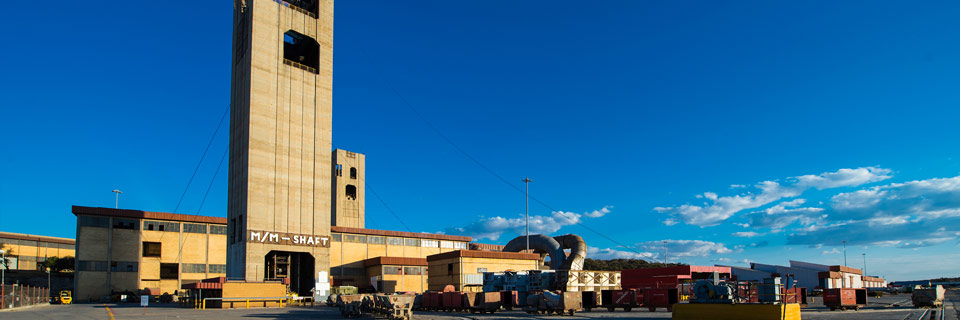
| FY14 | FY13 | FY12 | |
|---|---|---|---|
| Number of employees | |||
| – Permanent | 5 139 | 5 023 | 5 237 |
| – Contractors | 1 302 | 909 | 979 |
| Total | 6 441 | 5 932 | 6 216 |
| Operational | |||
| Volumes milled (000t) | 1 143 | 711 | 1 197 |
| Gold produced (kg) | 4 694 | 2 740 | 5 633 |
| Gold produced (oz) | 150 916 | 88 093 | 181 105 |
| Grade (g/t) | 4.11 | 3.85 | 4.71 |
| Productivity (g/TEC) | 73.60 | 42.86 | 90.20 |
| Development results | |||
| Total metres | 15 077 | 9 361 | 15 224 |
| Reef metres | 3 107 | 1 487 | 2 723 |
| Financial | |||
| Revenue (Rm) | 1 959 | 1 213 | 2 320 |
| Average gold price received (R/kg) | 432 358 | 449 531 | 417 317 |
| Production profit/(loss) (Rm) | 206 | (271) | 881 |
| Capital expenditure (Rm) | 509 | 420 | 415 |
| Cash operating cost (R/kg) | 389 762 | 553 358 | 261 167 |
| All-in sustaining cost (R/kg) | 522 347 | 742 033 | 336 977 |
| Safety | |||
| No of fatalities | 3 | 2 | 4 |
| Lost-time injury frequency rate per million hours worked | 9.56 | 4.25 | 5.57 |
| Environmental | |||
| Electricity consumption (MWh) | 664 | 580 | 683 |
| Water consumption – primary activities (ML) | 1 418 | 2 591 | 4 193 |
| greenhouse gas emissions (000t CO2e) | 660 | 574 | 676 |
| Intensity data per tonne treated | |||
| – energy | 0.58 | 0.82 | 0.57 |
| – water | 1.23 | 3.64 | 3.5 |
| – greenhouse gas emissions | 0.58 | 0.81 | 0.56 |
| Number of reportable environmental incidents | 2 | 2 | 1 |
| Community | |||
| Local economic development (Rm)* | 65 | 21 | 2 |
| Training and development (Rm) | 37.1 | 34.5 | 41.0 |
* Included in the total for FY14 is an amount of R52 million that was capitalised as part of the hostel upgrades
Despite its erratic performance during 2013, Kusasalethu ranked among the most-improved of the South African operations as the mine’s continued production build-up resulted in it becoming the largest individual gold producer in the Harmony group. Gold production was up 71% on the year, a function of an increase in volumes milled and higher grades.
Following the industrial action in FY13, as a result of which the mine was closed for around three months, every effort was made to resume steady state production. Despite challenges encountered during the year such as safety stoppages, and a spillage and flooding of the bottom of the return ventilation shaft and sub-shafts that restricted hoisting, production in FY14 was almost back to normal. Production was also affected by three fatalities, one of which followed the failure of a backfill paddock and bag in the third quarter, and the resultant halt to production.
Water availability was reduced given excessive levels of mud in the underground storage dams and poor efficiency of the settler dams continued to affect stoping and development. This problem had been resolved by year-end. Engineering capacity at Kusasalethu has been increased to help ensure that potential infrastructural risks are identified and addressed.
A comprehensive plan was implemented to reduce the widening gap between delivered and recovered grades, the positive results of which were seen from April onwards.
Union rivalry was challenging and hindered performance and efficiency. In October 2013, the mine recognised Association of Mineworkers and Construction Union as the employees' main representative union after 75% of the unionised workforce had joined Association of Mineworkers and Construction Union. This was followed early in the third quarter by a threatened wage strike as Association of Mineworkers and Construction Union had not participated in or agreed to the two-year wage agreement reached in collective bargaining during 2013. The Labour Court ruled, however, that such a strike would be unprotected and the union complied with the court’s ruling.
There is much potential to increase volumes mined at Kusasalethu. The grade dilution resulting from the ore pass rehabilitation continues and the magnitude of repairs required to rehabilitate the ore pass was more severe than expected. The date for completion is now set for the end of the 2019 calendar year.